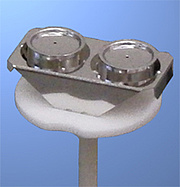A differential scanning calorimeter (DSC) Netzsch DSC 404 was added to our setup and incorporated into the basic measurement routines for data in the temperature range of about 500 to 1500 K. The DSC is able to perform accurate specific heat capacity measurements in the above mentioned temperature range. The results are combined with those of the pulse-heating experiments by using the enthalpy versus temperature dependence of the DSC to expand the temperature range of the pulse-heating data. Thus, temperature dependences of all thermophysical properties can now be extended down to the DSC onset temperature of about 500 K.
The DSC can be used primarily for measurements of the heat capacity of the sample (5.2 mm diameter and 0.5 mm height) in the temperature range from 500 to 1500 K. The sample is measured relative to a second, inert sample of approximately the same heat capacity. One experiment consists usually of three separate runs: a scan with two empty pans, a scan with one pan containing a sapphire reference sample, and finally a scan with the sample in the same pan where the reference sample was previously. The heat capacity as a function of temperature of the sample under investigation, cp(T), is obtained by using the following equation:


All images © TU Graz/Institute of Experimental Physics
